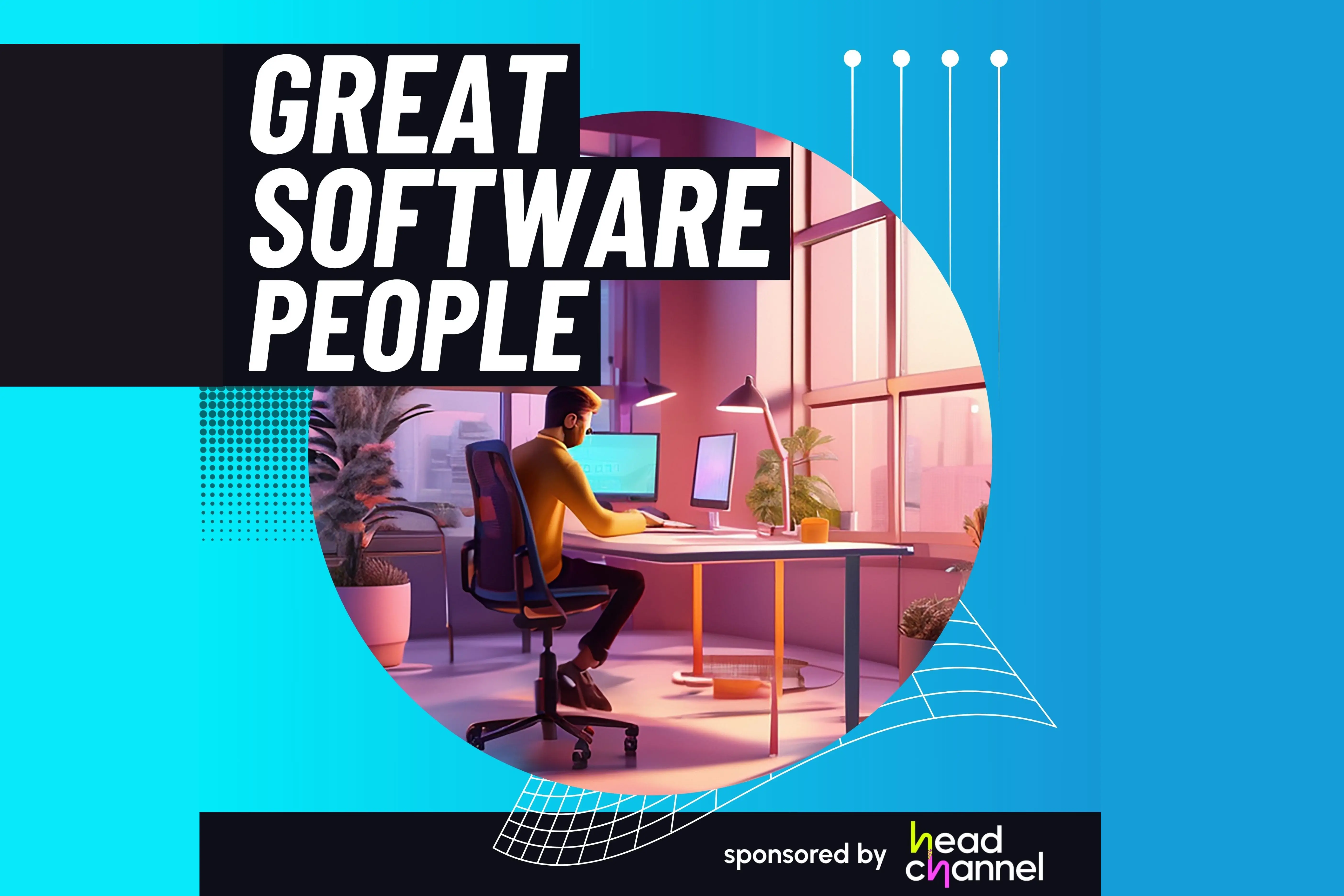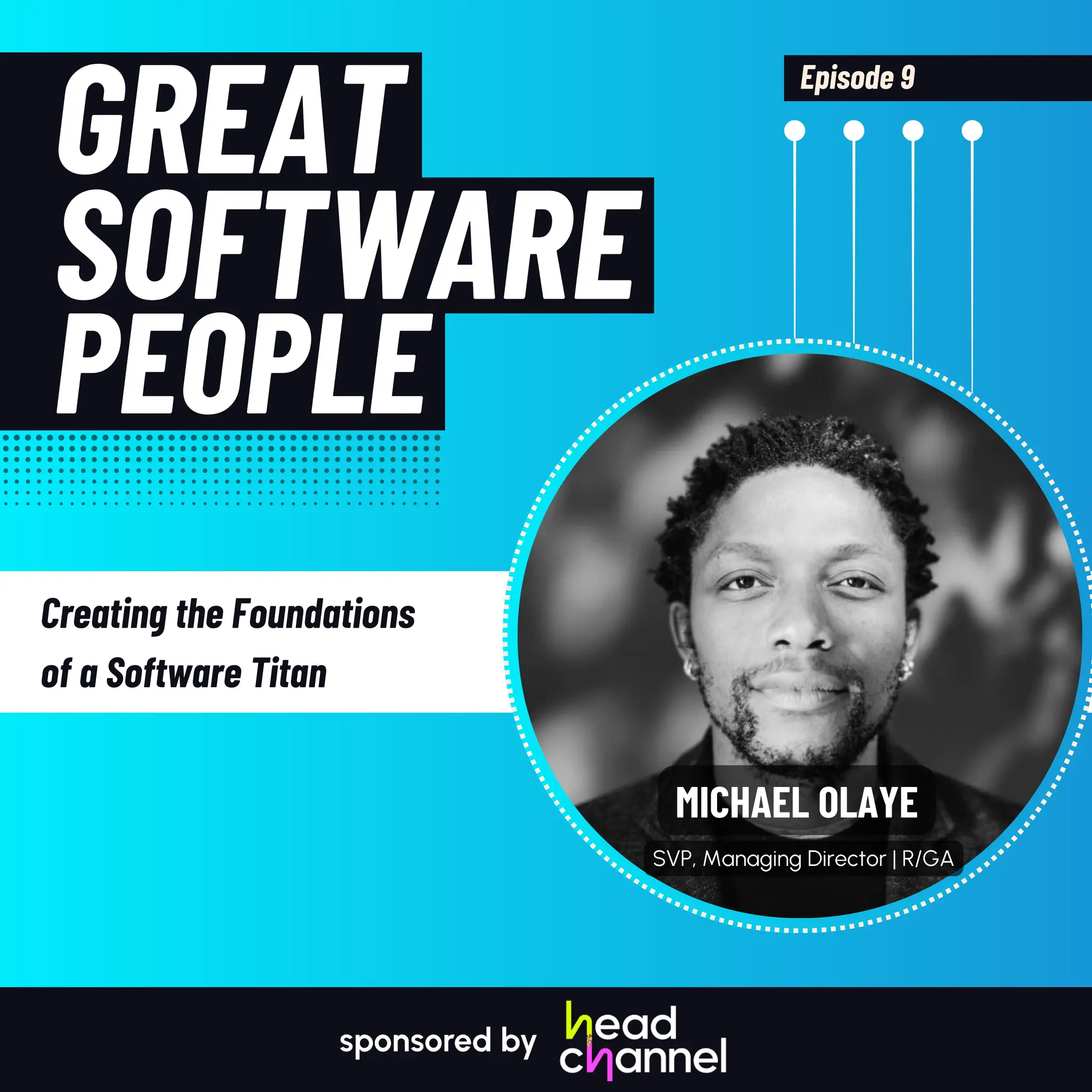
Creating the Foundations of a Software Titan with R/GA’s SVP, Managing Director, Michael Olaye - E9
Michael Olaye’s career has seen him thrive across several roles in software, with a roster of clients reading like an all-star cast, from adidas to Playstation, EMI to BMW Group.
With such a stellar route through the industry, he’s got a keen eye for innovation in all its evolving forms - learn more from Michael’s decades of insight, and how he carved his route to becoming SVP, Managing Director at R/GA, on this week’s ‘Great Software People’.
This episode covers:
-
Stories from the agency world at Hyperlink and OLIVER
-
The thriving success of U-Dox in his 10 year tenure
-
All that Michael owes to an eye-opening stint at Havas
-
The shifting nature of innovation today
-
Whether the future of innovation lies within software or hardware

Episode highlights
“The idea was to get clients and turn into a proper agency, which we did with brands like Nike, Adidas, EMI, Universal, Nickelodeon - we had some great stuff.” - 8:10 - Michael Olaye
“I joined, luckily, just as Oliver was pitching for one of the biggest platform bills BMW had out there.” - 20:30 - Michael Olaye
“Innovation is a crazy word. Do I wait for someone to create something innovative and apply it on top of my thinking, or do I create something painful that’ll drive the industry forward?” - 29:10 - Michael Olaye
“I think we’re good on software. I think we can technology stack, we can write code on top of each other, we can merge things, we can pull out stuff. That’s not a problem. I think where we’re going now, we’ll get there because hardware is starting to catch up.” - 40:50 - Michael Olaye
LISTEN HERE:
[00:00:13]
Rich: Welcome to another episode of Great Software People. I’m thrilled to have someone with me today who I deeply respect and have had the pleasure of working with in the past. He’s had an extraordinary career trajectory, and today, we’ll explore how he got to where he is. Joining me is Michael Olaye, SVP Managing Director, Strategy Innovation at R/GA. Welcome, Michael!
Michael: Thanks, Rich. It’s a pleasure to be here. We’ve known each other for quite some time, and I’m glad to be on your podcast.
[00:01:00]
Rich: Let’s start right at the beginning. How did your journey into software begin?
Michael: It’s a simple story, really. Around 1995 or 1996, my ex-girlfriend’s husband at the time had a collection of books, and one of them caught my eye—HTML for Dummies. I was studying electrical engineering at university, and I picked it up out of curiosity. I read it on the train without a computer to try anything out. I just absorbed the concepts—HTML, JavaScript, command line code—by reading. After about two months, I finally tried some code on Notepad. I made a text scroll and change colour, and it just blew my mind. I’ve been hooked ever since.
[00:02:28]
Rich: And from that start, you eventually became a Flash developer, right?
Michael: Not right away. I started as a solid HTML and JavaScript developer and spent two years honing that. Then I dabbled in Macromedia Director, the precursor to Flash. I worked with lingo code and transitioned into Flash when it became more powerful. While many people used Flash for timeline animations, I was more focused on ActionScript. I loved writing code that delivered stunning visual effects. My very first Flash project even won Adobe Designer of the Month, which was ironic because I wasn’t a designer—I was just a coder.
[00:03:47]
Rich: It sounds like the visual side of coding always excited you.
Michael: Absolutely. I’ve always been fascinated by experiences—how interfaces make people feel. My first job was at Hyperlink Interactive in Covent Garden. I was hired as a coder but worked closely with creatives, which exposed me to their perspective. It shaped how I approached writing software.
[00:04:29]
Rich: Any memorable projects from your time at Hyperlink Interactive?
Michael: Loads. Hyperlink was a massive agency, like what Sapient is today. We built one of the UK’s first credit card platforms, Goldfish. We also worked on projects for the Post Office and Royal Mail. But my favourite was the Yellow Submarine project. It was an interactive movie based on the quirky nature of The Beatles. It had isometric planes, fish boxing in rings, and surreal animations. That project won me the Adobe award. It was also the first time I built lasting friendships in the industry—one of those friends even helped me start my next venture.
[00:06:24]
Rich: And your next venture was Udox, where you spent a decade.
Michael: Yes. After Hyperlink, my friend Chris Law invited me to join Udox, originally called Unorthodox Styles. We had three brands: Crooked Tongues (a sneaker resource later acquired by ASOS), Spine TV (a music video platform before YouTube existed), and Spine Magazine (a hip-hop fanzine). When I joined, we didn’t have clients—it was more of a passion project. My role was to help turn it into a proper agency. Over time, we brought in clients like Nike, Adidas, EMI, and Universal. I did everything—coding, setting up e-commerce platforms, and even driving to install servers.
[00:09:00]
Rich: Sounds like a chaotic but exciting time.
Michael: It was. We had to figure everything out as we went. For instance, we didn’t have APIs or plugins for payment systems back then. We encrypted credit card details manually, sent them via email, and processed them on physical terminals. It was a lot of trial and error, but that’s what made it fun. I also loved the sense of community. I’d spend hours on Stack Overflow, attend developer meetups, and troubleshoot problems with peers. Those were formative years for me.
[00:11:22]
Rich: After Udox, you joined Havas, where we met. What was that transition like?
Michael: Havas was transformative for my career. I joined in 2010 to build their digital offering from scratch. At the time, they didn’t have one. Russ Lidstone, the CEO, had an incredible vision to turn Havas into a full-service agency. He gave me complete autonomy to make it happen. Those six years were amazing. I learned how to build teams, win new business, and drive innovation at scale. I had great mentors like Kate Robinson, who taught me about the workings of an agency.
[00:13:51]
Rich: Any standout projects at Havas?
Michael: There were plenty. One that stands out was a 3D app we built for Credit Suisse. It was a first-of-its-kind interactive experience for iPhones and Androids. We also did a lot of groundbreaking work for clients like New York House of Symphony and Symphonix.
[00:17:19]
Rich: You then moved to Oliver, which focuses on in-housing. What drew you to that?
Michael: Many thought I was crazy to leave Havas for an in-housing agency, but I saw huge potential in Oliver’s vision. They weren’t just about churning out content—they wanted to push boundaries. As Group CTO, I focused on integrating the different agencies they acquired, like Dare and Adjust Your Set, into a cohesive system. We also worked on significant projects like a platform for BMW Group. It was an opportunity to apply my tech and business skills at scale.
[00:24:55]
Rich: Then you moved to Sweden. How was that experience?
Michael: It was my first time fully stepping away from hands-on coding. I focused entirely on team-building, strategy, and design. I worked as Chief Growth Officer for a group of agencies and learned a lot about cultural differences and management at an international level.
[00:30:34]
Rich: And now you’re at R/GA, one of the world’s most respected agencies.
Michael: Yes, R/GA is unique. The talent here is unmatched—hybrid thinkers who combine design, strategy, and technology. I’ve been lucky to have Bob Greenberg, R/GA’s founder, as a mentor. He’s taught me so much about evolving an agency. At R/GA, we’re not just building software—we’re creating entire ecosystems. It’s about combining products, experiences, and content into seamless solutions for clients.
[00:38:00]
Rich: Any final thoughts on the future of innovation?
Michael: Innovation is entering a new phase. We’ve nailed software development, but the next leap will come from hardware—think quantum computing, spatial computing, and AI integration. It’s also about bringing disciplines together—design, technology, and business strategy. Agencies need to be at the table when these innovations are being developed, not just applying them later.
[00:43:00]
Rich: Michael, we could talk for hours. You’ve had an incredible career, from coder to CEO, and now SVP at R/GA. Thank you for sharing your journey.
Michael: Thanks, Rich. I’d love to come back and dive deeper into some of these topics. It’s been a pleasure.

Contact us.
If you need a partner in software development, we're here to help you.
We will respond to your enquiry immediately.